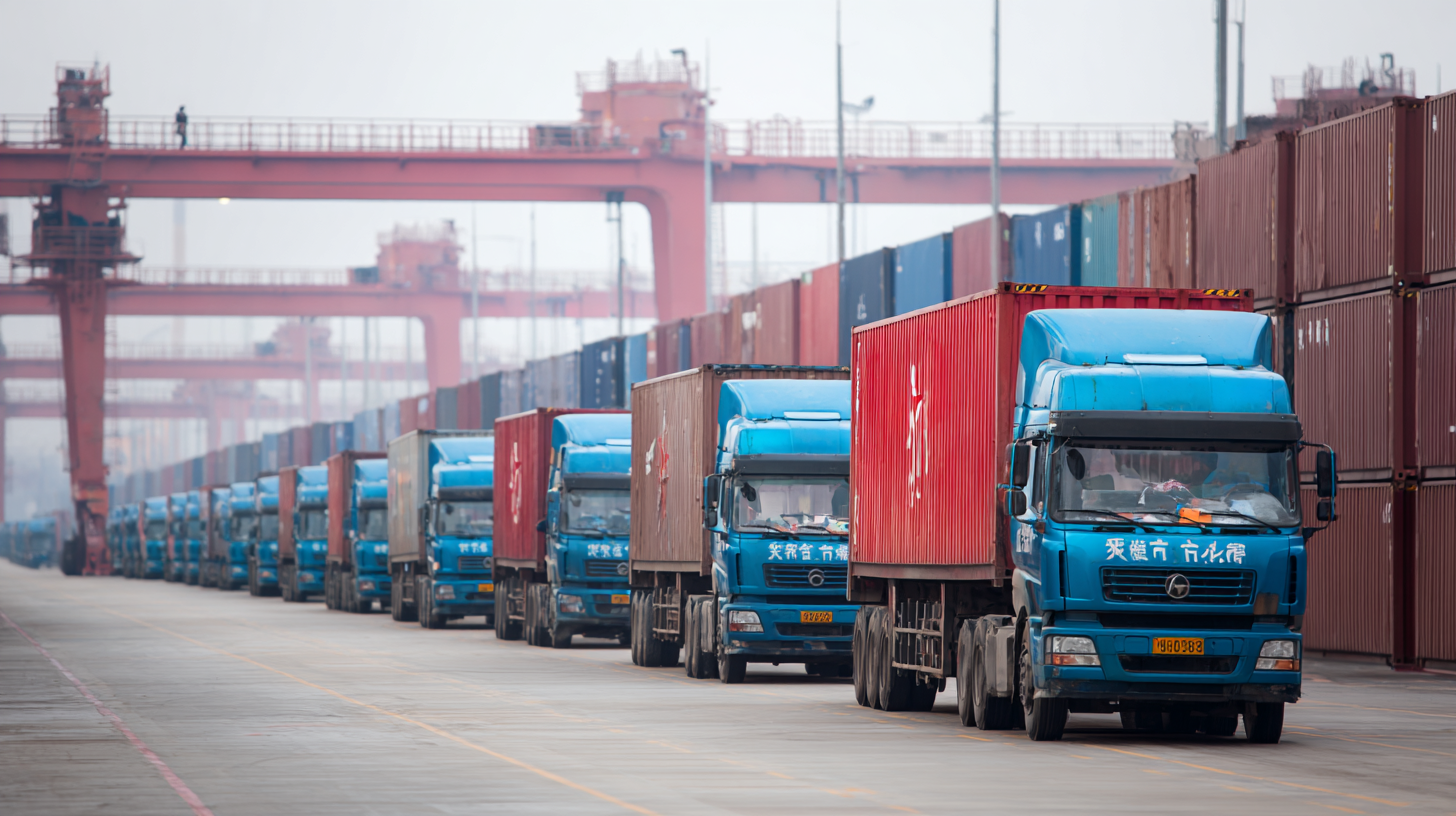In the rapidly evolving landscape of e-commerce, mastering China Amazon Logistics has become a critical factor for success. According to a report by Statista, the e-commerce market in China is projected to reach over $2 trillion by 2023, presenting immense opportunities for businesses looking to capitalize on this growth. Effective logistics strategies are essential to navigate the complexities of supply chain management, especially when dealing with the vast scale of products and services offered by Amazon in China. A study from the China National Logistics Association indicates that optimizing logistics processes can reduce operational costs by up to 30%, highlighting the importance of strategic planning. As businesses strive to enhance their competitive edge, understanding the intricacies of China Amazon Logistics and implementing tailored strategies will be crucial for achieving efficiency, cost-effectiveness, and customer satisfaction in this thriving market.

China's e-commerce landscape is rapidly evolving, becoming a critical component for effective Amazon logistics. As Chinese platforms expand their operations globally, particularly in Europe, warehouse growth accelerates to accommodate the increasing volume of goods. Reports indicate that the Southeast Asian market is poised to triple, with a compound annual growth rate of 22%, reaching an estimated $230 billion in gross merchandise volume. This tremendous growth highlights the urgency for logistics players to adapt and optimize their supply chains to keep pace with the rising demand and fierce competition from emerging players.

The competition is intensifying as alternative platforms reshape the U.S. e-commerce market, putting Amazon's dominance to the test. The rise of new entrants and the expansion of logistics capabilities have created a complex environment, necessitating a strategic re-evaluation of logistics operations within China. As logistics pressures mount and regulatory changes loom, companies must streamline their processes and develop robust distribution networks to ensure timely and efficient service delivery. By understanding these dynamics, Amazon can navigate the competitive landscape more effectively and maintain its position within the global e-commerce ecosystem.
Navigating customs regulations is crucial for businesses looking to thrive in the competitive landscape of China Amazon logistics. With China tightening its customs compliance measures, companies must stay informed of the latest regulations to avoid disruptions. Industry reports indicate that adherence to customs policies can enhance operational efficiency by up to 30%, allowing businesses to streamline their import and export processes.
Tips for compliance include thoroughly understanding China’s export control regulations, which require businesses to be aware of dual-use items that may be subject to additional scrutiny. Developing a robust relationship with local customs authorities can facilitate smoother customs clearance, ultimately reducing delays in logistics operations. Additionally, companies should regularly train their staff on the evolving customs landscape to keep pace with any changes.
Moreover, leveraging technology and data analytics can provide insights into customs trends and potential bottlenecks in the supply chain. By analyzing shipping patterns and regulatory changes, businesses can proactively adjust their strategies, ensuring compliance while promoting efficiency. As highlighted in recent discussions around global trade, adaptability and informed decision-making are key to mastering customs navigation in the ever-changing marketplace.
This bar chart illustrates the importance of various compliance strategies when navigating China Amazon logistics. Each strategy represents a critical area that contributes to smooth operations.
Selecting the appropriate fulfillment options is crucial for China Amazon sellers who aim to optimize their logistics performance. Balancing cost and speed involves understanding the diverse shipping methods available, from express services to standard delivery. Express shipping, while faster, can significantly elevate overhead costs. Therefore, it is essential for sellers to analyze their target market demands. If a product's competitiveness hinges on rapid delivery, investing in express services may be justified. Conversely, for non-urgent items, leveraging standard shipping can lead to substantial savings without compromising service quality.
Moreover, using Fulfillment by Amazon (FBA) or third-party logistics (3PL) can significantly impact a seller's logistics strategy. FBA allows sellers to tap into Amazon's established fulfillment network, ensuring quick delivery times and enhanced customer trust. However, the storage fees and shipping costs associated with FBA can add up. Alternatively, 3PL providers offer flexibility and potentially lower costs while allowing sellers to maintain control over inventory management and shipping processes.
Ultimately, a strategic evaluation of fulfillment options will help China Amazon sellers achieve a balanced approach that meets both their budgetary constraints and speed requirements, ensuring a competitive edge in the marketplace.
In the rapidly evolving landscape of e-commerce in China, leveraging technology and data analytics is crucial for optimizing logistics performance.
By using cutting-edge logistics management software, businesses can gain real-time visibility into their supply chains.
This transparency allows for more informed decision-making, reduces delays, and minimizes costs, ultimately enhancing customer satisfaction.
Tip:
Implement an integrated logistics platform that combines real-time tracking and inventory management. This can streamline operations and provide valuable insights into shipping patterns and delivery times, enabling businesses to respond swiftly to market demands.
Additionally, data analytics can play a pivotal role in forecasting and demand planning.
By analyzing historical sales data and consumer behavior, companies can predict peak periods and adjust their inventory accordingly.
This proactive approach not only ensures product availability but also reduces excess stock, leading to lower storage costs.
Tip:
Use predictive analytics tools to identify trends and seasonal fluctuations. This will empower you to make strategic inventory decisions, ensuring that your logistics operations remain agile and responsive to changes in the marketplace.

Building strong partnerships with local logistics providers is essential for businesses aiming to succeed in the competitive landscape of China’s Amazon logistics. Collaborating with well-established local firms can provide invaluable insights into the unique challenges and opportunities within the Chinese market. These partnerships enable companies to leverage the local expertise, ensuring that they navigate regulatory hurdles, customs requirements, and distribution networks effectively.
Moreover, working closely with local logistics experts can lead to innovative solutions tailored to specific regional demands. By integrating their knowledge of consumer behavior and market trends, businesses can enhance their supply chain efficiency and responsiveness. This strategic alliance not only improves operational capabilities but also fosters flexibility in adapting to market shifts, giving companies a significant competitive edge when it comes to fulfilling customer expectations in the fast-paced e-commerce environment.
| Strategy | Description | Benefits | Challenges | Partnership Type |
|---|---|---|---|---|
| Utilizing Local Knowledge | Leverage the expertise of local logistics providers who understand the regional market. | Improved efficiency and reduced shipping times. | Potential communication barriers and differing operational standards. | 3PL Partnerships |
| Integrated Technology Solutions | Implement advanced software for real-time tracking and inventory management. | Enhanced visibility and better decision-making. | High initial costs and ongoing maintenance challenges. | Tech Collaborations |
| Flexible Transportation Options | Utilize a variety of transportation methods to adapt to changing demands. | Greater resilience against disruptions. | Complex logistics planning and higher operational costs. | Multi-modal Partnerships |
| Customer-Centric Approaches | Focus on providing personalized services based on customer preferences. | Increased customer loyalty and satisfaction. | Resource intensive and requires robust feedback mechanisms. | Customer Service Collaborations |
| Regulatory Compliance Strategies | Ensure adherence to local laws and regulations concerning logistics and shipping. | Minimized risk of legal penalties and improved reputation. | Constantly evolving regulations and need for ongoing training. | Legal Partnerships |

